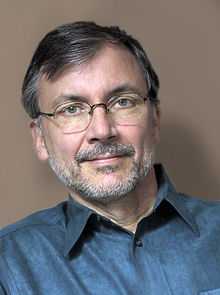Eric J. Heller
| Eric J. Heller | |
|---|---|
 Eric Heller (2005) | |
| Born | January 10, 1946 |
| Residence | Cambridge, MA |
| Nationality | American |
| Fields |
Theoretical Chemistry Physics |
| Institutions | Harvard, UCLA, Los Alamos National Laboratory, University of Washington |
| Alma mater | Harvard University |
| Doctoral advisor | William P. Reinhardt |
| Doctoral students | Gregory A. Fiete |
| Known for | Pioneering a time-dependent perspective of molecular spectroscopy and reaction dynamics. |
| Notable awards | National Academy of Sciences (2006), American Chemical Society Award in Theoretical Chemistry (2005). |
Eric J. "Rick" Heller (born January 10, 1946) is the Abbott and James Lawrence Professor of Chemistry and Professor of Physics at Harvard University. Heller is known for his work on time dependent quantum mechanics, and also for producing digital art based on the results of his numerical calculations.
Heller is principally known for pioneering a time-dependent wavepacket picture of quantum mechanics, which allowed the excited-state dynamics of large quantum mechanical systems to be understood without calculating eigenstates. Heller's work laid the foundations for a theoretical understanding of femtochemistry. Heller has also made seminal contributions to methodology, suggesting the technique called "frozen Gaussians"—today the most widely used semiclassical initial value representation (IVR) method of wavepacket propagation.
In physics, Heller is known for his work on quantum chaos, particularly on scar theory. Heller's more recent work has focused on the study of two dimensional electron gases, quantum mirages in quantum corrals, scattering theory, few-body quantum mechanics, semiclassical methods, and freak waves in the ocean. Many (though not all) of these studies make use of the time-dependent quantum mechanics ideas from his earlier work.
Heller is an elected member of the International Academy of Quantum Molecular Science, the National Academy of Sciences, the American Academy of Arts and Sciences, and the American Association for the Advancement of Science. Heller has received the American Chemical Society Award in Theoretical Chemistry (2005), the Astor Fellowship at Oxford (2005) and the Joseph O. Hirschfelder Prize (2003). Heller has been a Sloan Fellow, a Humboldt Fellow, a fellow of the American Physical Society, and a Guggenheim Fellow, and is the coauthor of over 260 publications.
Heller received his BS from the University of Minnesota in 1968, and his PhD in Chemical Physics in 1973 from Harvard University, where he worked with William Reinhardt. Heller was a postdoc at the University of Chicago with Stuart Rice, after which he joined the faculty at the University of California, Los Angeles. In 1981, Heller took a sabbatical at Los Alamos National Laboratory and then stayed on as a staff scientist until 1984 when he accepted a faculty position in Chemistry at the University of Washington. In 1993, Heller returned to Harvard as Professor of Physics and director of the Institute for Theoretical Atomic Physics (ITAMP) (1993–1998). In 1998, Heller stepped down as ITAMP director to assume a joint appointment to the Harvard University Chemistry department. His present position is Professor of Physics and Chemistry at Harvard.
Heller's father was the economist Walter Heller.
Heller is mentioned in the Nebula Award winning novel The Quantum Rose by Catherine Asaro, a science fiction novel based in part on Heller's theories. Asaro, who was a student of Heller's, dedicated the book to him and her other two mentors, Alex Dalgarno and Kate Kirby.
Sources
- International Academy of Quantum and Molecular Sciences
- Nanoscale Informal Science Education Network
- Lawrence Technological University Cisler E. Walker Lecture Series
- The Quantum Rose, Catherine Asaro, Tor Books, 2000